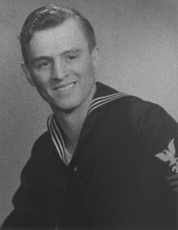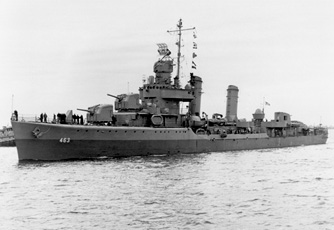 |

|
Ernie (Sandy) McKay
Machinist Mate, 2nd class, USS Corry (DD-463)
Aboard the
destroyer USS Corry (Dd-463), commanded by Lieutenant Commander
George D. Hoffman on Tuesday, June 6, 1944, at H-Hour and at my General
Quarters station on the lower level of the forward engine room, I found
myself seated on a small, raised section of floor plate beneath a blower and
realizing that excessive maneuvering was taking place, I could hear the
sound of something hitting the sides of the ship behind me. It sounded as if
someone was throwing stones at the sides of the ship below the water line.
Later, coming to the realization that this was the shelling that the German
gunners were engaged in, trying to hit us. We were out of the smoke screen
that was supposed to keep us from being seen, while performing our mission
of shelling designated targets that spotters relayed to us, but the smoke
screen plane that was to have screened us had been shot down.
I understand that Captain Hoffman did a magnificent job of evading being hit for quite awhile by his ability at maneuvering. The swept lane of mines was narrow and not much room was allowed to be able to stray out of this pocket, so eventually the inevitable happened.
On the lower level of the engine room I had started walking around the engineering space checking the various machinery gauges, and was walking towards the evaporators when suddenly a tremendous explosion took place. This was a mine exploding beneath the forward fire room just in front of the engine room.
Floor plates were torn loose and the sound of rushing water that was pouring into the space was heard. The swish, swish sound of the propeller shaft was quite pronounced also. There was complete blackness here in the recesses of the ship. I was completely disoriented having been spun around and found myself standing in the bilge with no floor plate to stand upon and not knowing where the ladder to the upper level was. I had been hit in the head and hand by a floor plate, from the upper level I presume. About this time the main hatch was opened to the main deck and without floor plates on the upper level to restrict my view, I could see a little daylight from the main deck opening. I don't know how I did it but I pulled myself up to the upper level and managed to work my way toward the main engine room ladder and up into the machine shop and then out to the main deck.
Someone, evidently an engineering person, said, "Let's go back to the after engine room and see if we can do anything to help keep the ship in an operating mode." Going back there we found that no steam was available therefore nothing could be done.
Leaving the after engineering space I headed forward to the machine shop area to look down into the forward engineering space and the water level was almost to the floor level of the machine shop.
About this time word was being passed to abandon ship. My life belt was still down in the engine room lower level where I had it hanging, not wishing to have it on while down there. Stupid me! The water level at this time was above the main deck amidships as the ship's back under the engineering spaces had been broken.
I removed my shoes and seeing a cork life net, quite a large mass, held together with ropes floating a short distance from the ship I decided to swim to it. Woe to me! The net tried to drown me. There was no way to keep afloat with it. I would grab at it and it would pull me under. After several attempts at the farcical conglomeration, I decided to swim back to the ship and take my chances on it as it looked as if it was already settled to the bottom and evidently it was. At this time the Germans were shelling the ship and exploding shells above the heads of the men in the water occasionally.
Getting back onto the ship, I noticed that the starboard whaleboat was being loaded with some wounded men. At this time blood was trickling slightly from the cut over my eye and someone said, "Get into the boat son."
The Pharmacist Mate in the whaleboat treated my cut over the eye and the laceration on my hand. We floated around for a couple of hours, as the whaleboat engine would not run.
Eventually the destroyer USS Fitch (DD-462) sent their whaleboat to pick up survivors. Some of us were ushered from the Corry's whaleboat, which was heavily loaded, into the Fitch's whaleboat and brought over to the destroyer. On the ship I was given a pair of high top brown army shoes, Navy blue sailor pants, a long john underwear top, and an army type fatigue cap. The Fitch men were very helpful giving up their own personal clothes in many instances. I was the weirdest looking sailor that you could ever see.
We were then brought to the transport USS Barnett which, after loading herself with many wounded men, proceeded to a port in Southern England. We were placed in a hospital overnight and then put aboard a train, living on K-Rations, and headed north through the countryside of the British Isles to Scotland.
In Scotland we resided at a base that was a place where troops were gathered prior to the invasion. This was a leisurely type two weeks while we were awaiting transportation back to the State, which came in the form of the liner Queen Elizabeth, which during the war was playing the role of British transport.
We
ended up at Pier 92 in New York, which was a naval receiving station, right
next to the pier where the Queen Elizabeth was tied up. After the
preliminary check ups, etc., we were given the basic white uniforms to go on
30 days survivor leave. We would receive the rest of our sea bags after
leave and then receive our new assignment.
Ernie (Sandy) McKay
Machinist Mate, 2nd class
USS Corry (DD-463)
Note: Ernie (Sandy) McKay was stationed aboard the USS Corry (DD-463)
for 2 years, 1 month, and 1 day. He advanced from Seaman, 2nd Class to
Machinist Mate, 2nd Class, during this period.